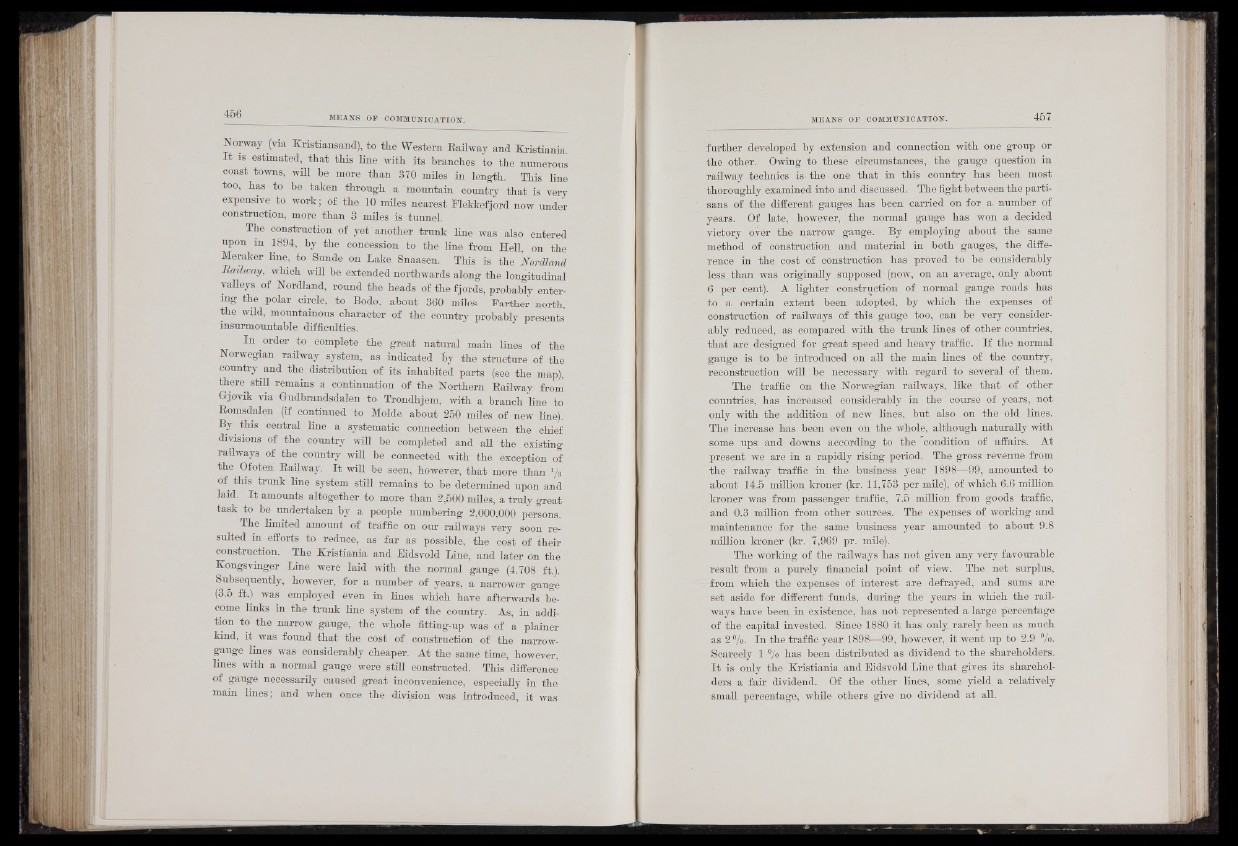
Norway (via Kristiansand), to the Western Railway and Kristiania.
I t is estimated, that this line with its branches to the numerous
coast towns, will be more than 370 miles in length. This line
too, has to be taken through a mountain country that is very
expensive to work; of the 10 miles nearest Flekkefjord now under
construction, more than 3 miles is tunnel.
The construction of yet another trunk line was also entered
upon in 1894, by the concession to the line from Hell, on the
Meraker line, to Sunde on Lake Snaasen. This is the Nordland
Bailway, which will be extended northwards along the longitudinal
valleys of Nordland, round the heads of the fjords, probably entering
the polar circle, to Bodo, about 360 miles. Farther north,
the wild, mountainous character of the country probably presents
insurmountable difficulties.
In order to complete the great natural main lines of the
Norwegian railway system, as indicated by the structure of the
country and the distribution of its inhabited parts (see the map),
there still remains a continuation of the Northern Railway from
Grjovik via Gudbrandsdalen to Trondhjem, with a branch line to
Romsdalen (if continued to Molde about 250 miles 0f new line).'-
By this central line a systematic connection between the chief
divisions of the country will be completed and all the existing
railways of the country will be connected with the exception of
the Ofoten Railway. I t will be seen, however, that more than Vs
of this trunk line system still remains to be determined upon and
laid. I t amounts altogether to more than 2,500 miles, a truly great
task to be undertaken by a people numbering 2,000,000 persons.
The limited amount of traffic on our railways very soon resulted
in efforts to reduce, as far as possible, the cost of their
construction. The Kristiania and Eidsvold Line, and later on the
Kongsvinger Line were laid with the normal gauge (4.708 ft.).
Subsequently, however, for a number of years, a narrower gauge
(3.5 ft.) was employed even in lines which have afterwards become
links in the trunk line system of the country. As, in addition
to the narrow gauge, the whole fitting-up was of a plainer
kind, it was found that the cost of construction of the narrow-
gauge hues was considerably cheaper. At the same time, however,'
lines with a normal gauge were still constructed. This difference
of gauge necessarily caused great inconvenience, especially in the
main lines; and when once the division was introduced, it was
further developed by extension and connection with one group or
the other. Owing to these circumstances, the gauge question in
railway technics is-the one that in this country has been most
thoroughly examined into and discussed. The fight between the partisans
of the different gauges has been carried on for a number of
years. Of late, however, the normal gauge has won a decided
victory over the narrow gauge. By employing about the same
method of construction and material in both gauges, the difference
in the cost of construction has proved to be considerably
less than was originally supposed (now, on an average, only about
6 per bent). A lighter construction of normal gauge roads has
to a certain extent been adopted, by which the expenses of
construction of railways of this gauge too, can be very considerably
reduced, as compared with the trunk lines of other countries,
that are designed for great speed and heavy traffic. If the normal
gauge is to be introduced on all the main lines of the country,
reconstruction will be necessary with regard to several of them.
The traffic on the Norwegian railways, like that of other
countries, has increased considerably in the course of years, not
only with the addition of new lines, but also on the old lines.
The increase has been even on the whole, although naturally with
some§|ups and downs according to the condition of affairs. At
present we are in a rapidly rising period. The gross revenue from
the railway traffic in the business year 1898—99, amounted to
about 14.5 million kroner (kr. 11,753 per mile), of which 6.6 million
kroner was from passenger traffic, 7.5 million from goods traffic,
and 0.3 million from other sources. The expenses of working and
maintenance for the same business year amounted to about 9.8
million kroner (kr. 7,969 pr. mile).
The working of the railways has not given any very favourable
result from a purely financial point of view. The net surplus,
from which the expenses of interest are defrayed, and sums are
set aside for different funds, during the years in which the railways
have been in existence, has not represented a large percentage
of the capital invested. Since 1880 it has only rarely been as much
as 2 °/o. In the traffic year 1898—99, however, it went up to 2.9 °/o.
Scarcely 1 % has been distributed as dividend to the shareholders.
I t is only the Kristiania and Eidsvold Line that gives its shareholders
a fair dividend. Of the other lines, some yield a relatively
small percentage, while others give no dividend at all.